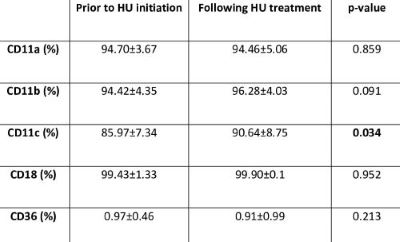
Contributions
Abstract: PB1772
Type: Publication Only
Session title: Sickle cell disease
Background
Hydroxyurea (HU) is a cytotoxic drug that is used in sickle cell disease (SCD) in order to ameliorate disease’s severity. Induction of HbF is reported as the main mechanism of action, however, other mechanisms contribute to its beneficial effect, given that some patients present with clinical improvement without an HbF increase. Sickle erythrocytes and activated circulating neutrophils contribute to vaso-occlusion by adhering to inflamed endothelium. B2-Integrins (CD11a, CD11b, CD11c and CD18), which are transmembrane adhesion receptors, are expressed exclusively on leukocytes. A number of studies have shown that HU decreases leucocyte adhesion, but the role of HU on B2 integrins expression has not been clarified. Moreover, there is conflicting data on the role of HU in decreasing CD36 - an adhesion receptor with increased expression on sickle reticulocytes and immature sickle erythrocytes.
Aims
Aim of present study was to evaluate the effect of HU on erythrocyte and leukocyte adhesion molecules in young patients with Sickle cell beta thalassemia.
Methods
Eleven young patients with Sickle cell beta thalassemia aged 3.5-18 years participated in the study. HU was given at a daily dose that ranged from 14.5 to 19 mg/kg, with a mean of 16.3mg/kg, for a 3year period. Expression of CD11a, CD11b, CD11c and CD18 on neutrophils, and of CD36 on reticulocytes was evaluated by flow cytometry.
Results
Before HU initiation all patients presented with normal expression of the CD11a, CD11b, CD11c and CD18 integrin subunits and increased expression of CD36. Following 3 years of therapy, expression of CD11a, CD11b and CD18 integrin, as well CD36 expression, were not found to be significantly altered. Of interest is the finding of a significant increase in the expression of the CD11c integrin subunit (p=0.034) (Table 1).

Conclusion
The present study failed to reveal an effect of HU on most of the adhesion molecules studied. In order to better interpret study results, evaluation in larger cohorts of Sickle cell beta thalassemia patients is warranted.
Keyword(s): Hydroxyurea, Sickle cell adhesion, Sickle cell disease
Abstract: PB1772
Type: Publication Only
Session title: Sickle cell disease
Background
Hydroxyurea (HU) is a cytotoxic drug that is used in sickle cell disease (SCD) in order to ameliorate disease’s severity. Induction of HbF is reported as the main mechanism of action, however, other mechanisms contribute to its beneficial effect, given that some patients present with clinical improvement without an HbF increase. Sickle erythrocytes and activated circulating neutrophils contribute to vaso-occlusion by adhering to inflamed endothelium. B2-Integrins (CD11a, CD11b, CD11c and CD18), which are transmembrane adhesion receptors, are expressed exclusively on leukocytes. A number of studies have shown that HU decreases leucocyte adhesion, but the role of HU on B2 integrins expression has not been clarified. Moreover, there is conflicting data on the role of HU in decreasing CD36 - an adhesion receptor with increased expression on sickle reticulocytes and immature sickle erythrocytes.
Aims
Aim of present study was to evaluate the effect of HU on erythrocyte and leukocyte adhesion molecules in young patients with Sickle cell beta thalassemia.
Methods
Eleven young patients with Sickle cell beta thalassemia aged 3.5-18 years participated in the study. HU was given at a daily dose that ranged from 14.5 to 19 mg/kg, with a mean of 16.3mg/kg, for a 3year period. Expression of CD11a, CD11b, CD11c and CD18 on neutrophils, and of CD36 on reticulocytes was evaluated by flow cytometry.
Results
Before HU initiation all patients presented with normal expression of the CD11a, CD11b, CD11c and CD18 integrin subunits and increased expression of CD36. Following 3 years of therapy, expression of CD11a, CD11b and CD18 integrin, as well CD36 expression, were not found to be significantly altered. Of interest is the finding of a significant increase in the expression of the CD11c integrin subunit (p=0.034) (Table 1).

Conclusion
The present study failed to reveal an effect of HU on most of the adhesion molecules studied. In order to better interpret study results, evaluation in larger cohorts of Sickle cell beta thalassemia patients is warranted.
Keyword(s): Hydroxyurea, Sickle cell adhesion, Sickle cell disease


